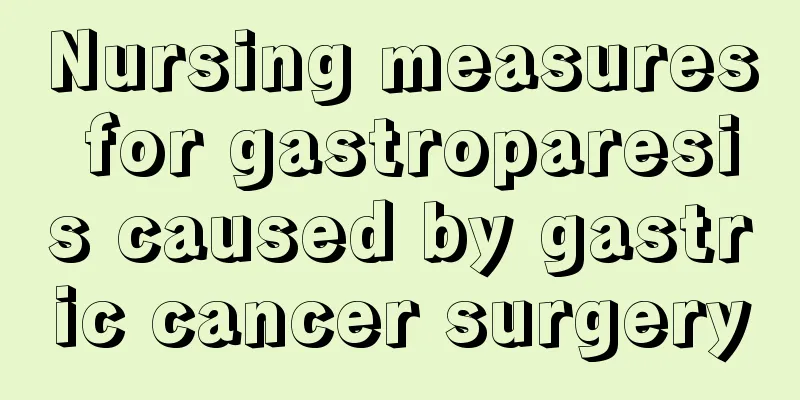Should I move more after cervical cancer surgery? How should I take care of myself after cervical cancer surgery

|
It is very important to properly adjust after cervical cancer surgery. Cervical cancer is a disease that will bring health problems to patients. There are many ways to diagnose cervical cancer, and people should understand the clinical diagnosis of cervical cancer. So, what should you pay attention to after cervical cancer surgery? The following aspects should be noted in postoperative care for cervical cancer: More activities: After cervical cancer surgery, more exercise can promote the recovery of intestinal peristalsis and reduce intestinal adhesion and intestinal obstruction. Early activities are conducive to ventilation and the discharge of tracheal secretions, but also promote blood circulation and prevent venous thrombosis. Six hours after routine surgery, patients should move their limbs and turn over in bed. General practice: On the first day after surgery, the patient can turn over and sit up. After the condition stabilizes, the patient can get out of bed and stand and walk with the help of a nurse or family member to effectively avoid complications. Supplement trace elements: After cervical cancer surgery, treatment should pay attention to timely supplementation of trace elements. Some trace elements are also very helpful for cancer prevention. Therefore, it is recommended to supplement more trace elements in the diet after cervical cancer surgery. For example, after cervical cancer surgery, the diet should pay attention to supplementing more vitamins, because low intake of B-carotene is a risk factor for cervical cancer. This can improve the body's ability to fight cervical cancer and effectively reduce the recurrence or development of cervical cancer. Drug-assisted treatment: Abdominal pain is a common phenomenon after cervical cancer surgery, and the pain usually gradually eases on the second day after surgery. There are usually two ways to relieve wound pain. One method is for the anesthesiologist to indwell a postoperative analgesic pump to inject painkillers; Another method is to inject painkillers when the pain is severe. This method has a good analgesic effect, but the duration is very short, usually lasting 2 to 4 hours. But you need to take the medicine under the guidance of a doctor. Body position: After returning to the ward after surgery, the patient should be placed in a supine position with a pillow, and in a semi-recumbent position after 6 hours (the time for changing body position is determined according to the anesthesia requirements). Diet: Full liquid diet after fasting for 6 hours, oral Simo decoction on the first day after surgery; semi-liquid diet after anal gas discharge; food can be eaten after large gas discharge. Functional exercise: Turn over once every 2 hours after surgery, passive lower limb exercise, and get out of bed 3 days after surgery. Disease observation: After surgery, closely observe blood pressure, pulse, and respiration, and measure them every 30-160 minutes until they are stable; pay attention to whether the wound dressing is bleeding, and change the dressing in time; observe whether the drainage tube is unobstructed, and record the color and amount of the drainage fluid. The drainage fluid is bloody 12 hours after surgery, but the drainage volume does not exceed 300mL. If the drainage fluid is bright red and the amount increases after 12 hours, there may be internal bleeding, and the doctor should be notified in time for appropriate treatment. Catheter care: properly fix to prevent falling off; during the indwelling of the catheter, scrub the vulva twice a day; encourage the patient to drink more water, more than 2000mL a day, to dilute the urine and flush the bladder; start to close the catheter on the 7th day after surgery, open it every 2-3 hours, and open it at night to exercise the bladder contraction function; after the catheter is removed, tell the patient to urinate every 1~2 hours; if the patient still cannot urinate after removal of the catheter, or the residual urine volume after removal of the catheter is >100mL, reinsert the catheter to continue training the bladder function. Reminder: You should also pay attention to your diet after cervical cancer surgery: According to experts, the early stage of cervical cancer generally has little impact on the digestive tract function, so patients can improve their disease resistance and immune function. Supplement nutrition, protein, sugar, fat, vitamins, etc. as much as possible; when vaginal bleeding occurs, take lotus root, coix seed, hawthorn, black fungus, black plum and other blood-tonifying, hemostatic and anti-cancer foods; when the patient's leucorrhea is watery, nourishing turtle, pigeon eggs, chicken, etc. should be taken. After cervical cancer surgery, women should focus on replenishing qi and blood, producing essence and replenishing essence. They can eat more yam, longan, mulberry, wolfberry, pig liver, turtle, sesame, donkey skin glue, etc. During cervical cancer surgery, women should focus on nourishing blood and yin, and can eat beef, pork liver, lotus root, fungus, spinach, celery, pomegranate, water chestnut, etc.; during chemotherapy, the dietary conditioning of cervical cancer patients mainly includes spleen and kidney-strengthening yam powder, barley porridge, animal liver, placenta, donkey-hide gelatin, turtle, fungus, wolfberry, lotus root, banana, etc. Patients with advanced cervical cancer should choose high-protein, high-calorie foods, such as milk, eggs, beef, turtle, red beans, mung beans, fresh lotus root, spinach, winter melon, apples, etc. Patients with cervical cancer should avoid eating foods that are fat, mellow, spicy, fragrant, fried, fried, etc., which are damp, phlegm, hot, and easy to bleed. Avoid eating raw, cold, fruit, cold food, and difficult to digest food. I hope you can pay more attention to it. |
<<: Can constipation induce cervical cancer? What causes cervical cancer?
Recommend
6 common methods for treating bone spurs
Bone spurs are a very common disease in daily lif...
What are the appropriate treatments for thromboangiitis obliterans?
Thromboangiitis obliterans is another type of art...
Which hospital is good for treating fibroids
Which hospital is good for fibroids? Choosing a h...
Can I take anti-inflammatory drugs while getting eyebrow tattooed
Every part of the five facial features is very im...
What is the method of singing with abdominal breathing?
If you want to learn how to sing, the first thing...
What causes eye floaters?
Eye floaters can affect our vision health. In man...
Preoperative nursing measures for laryngeal cancer patients
Patients with laryngeal cancer have a foreign bod...
What are the green bubbles in the throat?
Green bubbles in the throat are usually lymph fol...
What are the functions of the belt meridian
Many people may feel unfamiliar with the Dai Mai,...
How to clean silicone breast stickers?
Women all know about silicone breast stickers, wh...
Can drinking deer antler wine cure impotence?
Men are reluctant to talk about the problem of im...
How long can you live after surgery for papillary thyroid cancer
There are many types of thyroid cancer, among whi...
Precautions for enema, what diseases are not suitable for enema
Enema is the process of injecting medicine into t...
What are the good places to eat in Tianjin
Every place has its own special food, and local f...
What to do if there are small flying insects in the bedroom
Many insects are common in our daily lives, such ...









